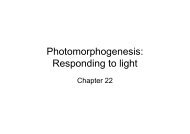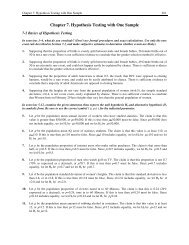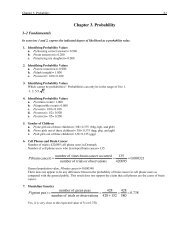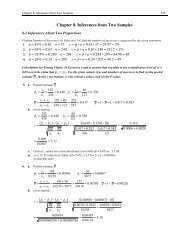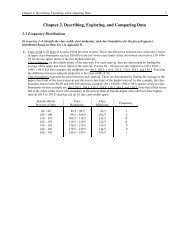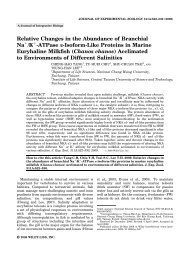Author's personal copy
Author's personal copy
Author's personal copy
You also want an ePaper? Increase the reach of your titles
YUMPU automatically turns print PDFs into web optimized ePapers that Google loves.
<strong>Author's</strong> <strong>personal</strong> <strong>copy</strong>42 W.-K. Yang et al. / Journal of Experimental Marine Biology and Ecology 375 (2009) 41–50and Lee, 2007). NKA in fish gills can be detected by immunocytochemicalstaining, and the number of Na + /K + -ATPase immunoreactive cells (NKA-IR cells) can be counted. Most branchial NKA was found to localize inMRCs; the number and distribution of the NKA-IR cells also changed withenvironmental salinities (Shikano and Fujio, 1998a,d; Sakamoto et al.,2001b; Lin et al., 2003; Hwang and Lee, 2007).For acclimation and survival, fish respond to environmental stressorsat many levels including increasing levels of blood glucose and heatshock proteins (HSPs). Blood glucose is an important source of energyfor the metabolism necessary to maintain physiological homeostasis andcope with environmental changes (Bashamohideen and Parvatheswararao,1972; Kelly et al., 1999). Usually the levels of blood glucose in fishincrease following exposure to stressful environments (Pottinger andCarrick, 1999) such as toxicants (Silbergeld, 1974), artificial habitat(Arends et al., 1999; Kubokawa et al., 1999), abnormal temperature(Tanck et al., 2000; Hsieh et al., 2003), handling or capture (Rotllant andTort, 1997; Frisch and Anderson, 2005; Tintos et al., 2006), and osmoticchallenges (Bashamohideen and Parvatheswararao, 1972; Manceraet al., 1993; Soengas et al., 1995; Woo and Chung, 1995; Morgan andIwama, 1998; Kelly et al., 1999; Claireaux and Audet, 2000; De Boecket al., 2000; Diouf et al., 2000; Palmisano et al., 2000; Yavuzcan-Yıldızand Kırkağaç-Uzbilek, 2001; Sangiao-Alvarellos et al., 2003, 2005;Cataldi et al., 2005; Laiz-Carrión et al., 2005a,b; Arjona et al., 2007; Fiesset al., 2007; Choi et al., 2008). On the other hand, previous studiesindicated that in fish, the HSPs with high molecular weights such as 60,70, and 90 kDa interact with environmental stressors (Iwama et al.,1998,1999; Feder and Hofmann, 1999; Basu et al., 2002), e.g., abnormaltemperature (Dietz,1994; Sathiyaa et al., 2001; Cara et al., 2005; Buckleyet al., 2006; Rendell et al., 2006; Manchado et al., 2008) and externalosmolality challenges (Kültz, 1996; Smith et al., 1999; Palmisano et al.,2000; Pan et al., 2000; Deane et al., 2002; Deane and Woo, 2004;Todgahm et al., 2005; De Jong et al., 2006; Choi and An, 2008). Amongthem, HSP90 constituted about 2% of total cellular protein in allorganisms (Parsell and Lindquist, 1993). HSP90 was active in theenzymes, steroid hormone receptors, and cytoskeleton of variouscomponents of cell signaling and was regarded as an indicator toestimate the level of environmental stressors (Iwama, 1998; Iwamaet al., 2004). Furthermore, HSP90 is expressed in various fish organs(Iwama, 1998; Iwama et al., 1999) including gill (Dietz, 1994; Kültz,1996; Palmisano et al., 2000; Pan et al., 2000; Buckley et al., 2006; Choiand An, 2008)andliver(Dietz, 1994; Palmisano et al., 2000; Sathiyaa etal., 2001; Deane et al., 2002; Deane and Woo, 2004; Rendell et al., 2006;Wang et al., 2007). The liver is an important organ with more diversefunctionality than any other organ in the fish body, possible due to itslarge size, rich enzymatic content, HSP-sensitivity, and capacity forglycogen storage (Bond, 1996; Bruslé and Anadon, 1996; Iwama, 1998;Mwase et al.,1998; Sangiao-Alvarellos et al., 2003). Elevated branchial orhepatic HSP90 expression (protein or mRNA level) upon salinitychallenge was reported as an indicator of osmotic stress in teleosts(Palmisano et al., 2000; Pan et al., 2000; Deane et al., 2002; Choi and An,2008).The sailfin molly (Poecilia latipinna) is a livebearing species withlarge dorsal fins on the males (Nelson, 1984; Berra, 2001; Froese andPauly, 2008). They are natively distributed in low elevations fromNorth Carolina, USA, to Veracruz, Mexico (Nordlie et al., 1992; Ptacekand Breden, 1998; Froese and Pauly, 2008) and have been introducedto many countries (Froese and Pauly, 2008) including Taiwan (Shao,2008). Today the euryhaline sailfin molly is found in the shallowsurface water along the edges of lowland, ponds, streams, gullies,swamps, salt marshes, and estuaries (Nordlie et al., 1992; Froese andPauly, 2008). In Taiwan, the sailfin molly was mainly distributed in thelower reaches (FW) and river mouths (brackish water, BW) over thesouthwestern part (Shao, 2008). Similar to the other euryhalineteleosts, branchial NKA activity and plasma osmolality of SW sailfinmolly were found to be elevated with increasing salinity such ashypersaline water (Gonzalez et al., 2005). Moreover, branchial NKAactivity was thought to regulate physiological homeostasis whenindividuals were exposed to salinity/osmotic stress. Hence wehypothesized that branchial NKA expression of sailfin molly changedin response to salinity stress for homeostasis so that they were able tosurvive in environments of different salinities. The goal of the presentstudy was to profile the osmoregulatory mechanisms of the sailfinmolly upon salinity challenge by indicators including physiologicalparameters (plasma osmolality and muscle water content), biochemicalexpression (activity, α-subunit protein abundance, and immunoreactivecells of branchial NKA), and stress responses (plasma glucoseconcentrations and protein abundance of hepatic and branchialHSP90).2. Materials and methods2.1. Fish and experimental environmentsAdult sailfin molly (P. latipinna) of3.1±0.4gbodyweightand51.2 ± 27.3 mm standard length were captured from Linyuan, Kaohsiung,Taiwan (120.38° E 22.49° N) and transported to the laboratory.Seawater (35‰) and brackish water (15‰; BW) were prepared fromlocal tap water by adding standardized amounts of synthetic sea salt“Instant Ocean” (Aquarium Systems, Mentor, OH, USA). The fish werereared in BW at 25±1 °C for one week in the laboratory and thenacclimated to either fresh water (FW), BW, or SW with a daily 12 hphotoperiod for at least 4 weeks before sampling for the following testsand analyses. The parameters of the water were identical to our previousstudy (Wang et al., 2008). The water was continuously circulatedthrough fabric-floss filters and partially refreshed every three days. Fishwere fed a daily diet of commercial pellets ad libitum. In order toperform the following experiments, fish were fully anesthetized withMS-222 (100–200 mg/L) and placed on ice before sampling.2.2. Plasma analysesFish blood was collected from the caudal veins with heparinized1 ml syringes and 27 G needles. After centrifugation at 13,000 g, 4°Cfor 20 min, the plasma was stored at −20 °C prior to analysis. Plasmaosmolality was measured with the Wescor 5520 vapro osmometer(Logan, UT, USA). Plasma glucose concentrations were determinedaccording to the manufacturer's protocol (Sigma, St. Louis, MO, USA)using a Hitachi U-2001 spectrophotometer (Tokyo, Japan).2.3. Muscle water content (MWC)The muscle from the dorsum of the body of the adult fish of FW-,BW-, and SW-acclimated groups was sampled and muscle watercontent was determined as the percentage of weight loss after dryingat 100 °C for three days.2.4. Sample preparationThe gills and livers were dissected and rinsed in phosphate bufferedsaline (PBS; concentrations in mmol·l −1 : NaCl:137; KCl: 3; Na 2 HPO 4 :10; KH 2 PO 4 : 2; pH 7.4). The tissues were then blotted dry before furtheranalysis. The gills were fixed in 10% formalin for immunocytochemicaldetection or homogenized for immunoblotting and other analyses; thelivers were homogenized for immunoblotting. The gill and liverscrapings were suspended in the mixture of homogenization medium(concentrations in mmol·l −1 :imidazole-HCl:100;Na 2 EDTA: 5; sucrose:200; 0.1% sodium deoxycholate; pH 7.6) and proteinase inhibitor (10 mgantipain, 5 mg leupeptin, and 50 mg benzamidine dissolved in 5 mlaprotinin) (v/v: 100/ 1). Homogenization was performed in 2 mlmicrotubes with a Polytron PT1200E (Kinematica, Lucerne, Switzerland)at maximal speed for 30 s The homogenate was thencentrifuged at 13,000 g, 4°Cfor20min.Thesupernatantswere




